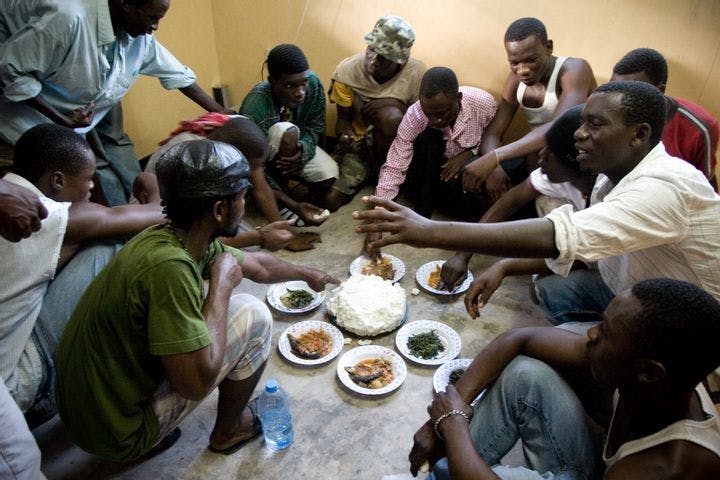Summer 2010
What's for Dinner in Africa
– Erica Bleeg
Particular dishes have become symbols of a rich and complicated culinary heritage that has spread into the African diaspora.
The sounds that stay with me from the years I lived in Benin are those of the several languages spoken there—and of cooking. I was a Peace Corps volunteer in the rural savanna, where food preparation was the domain of women, who cooked over coal or wood fires. Deftly wielding a wooden baton, my neighbor Nyaki stirred maize meal in a fire-licked pot. As the maize thickened toward the consistency of polenta, her baton went thwump, thwump, thwump. Or picture two women standing on either side of a three-foot mortar, each holding a long wooden pestle and taking plunges at boiled yams, pounding one after the other in a driving, two-beat tempo: barum, barum, barum, barum. Watching them, I’d wonder, how long have women been working these instruments on this food in this dance?
In Stirring the Pot, culinary historian James C. McCann offers a comprehensive history of the ingredients that have gone into the making of various African cuisines from 1500 to the present, and charts these foods’ global influence. For this huge undertaking, McCann focuses on the ways trade, politics, colonialism, and diaspora have shaped a dynamic and enduring gastronomic mélange. Maize, for example, came to Ethiopia via the Arab Red Sea trade and to West Africa from the West Indies in the 16th century, yet didn’t become the continent’s dominant cereal crop until the 20th century. Cheap and filling, maize made economic sense.
Anywhere along the maize belt, from Ethiopia down to South Africa and up to the Ivory Coast, a traveler can find a standard dish: maize flour boiled into a stiff porridge known as sadza in Zimbabwe, ugali in Kenya, and in the Bariba regions of Benin, dibu. In general, an African meal consists of a starch—often fixed in a form that holds together when eaten by hand—paired with a flavorful accompaniment. In Ghana, one may eat fufu (pounded yam, cassava, or plantains) with a choice of meat or vegetable sauce or with groundnut stew, whereas in the eastern maritime regions of Tanzania and Mozambique, the accompaniment is often what is called a “relish,” composed of fresh fish, meat, or green legumes.
Particular dishes have become symbols of a rich and complicated culinary heritage that has spread into the African diaspora. The popular Jollof rice dishes of Senegal, Gambia, and Nigeria, for example, appear in the United States as jambalaya, a classic New Orleans cuisine that reflects the West African principle of dafa (“cook everything”): Meat, fish, vegetables, and rice are cooked together in one pot. The dish owes its lineaments to African slaves. It also shows the influence of Canadians of French descent who were expelled from Nova Scotia by the British in 1755 and eventually found their way to Louisiana, then a colony of France; they contributed andouille sausage to the mix. Thus arose the name “jambalaya,” from the French jambon for ham and à la ya-ya, a generic West African reference to rice.
McCann includes several recipes, a signal that times are changing. Traditionally, Africans passed down knowledge orally; girls would learn the art of cooking by observing their elders, a familial apprenticeship from one generation to another. Now, African meals—and written recipes for them—are proliferating around the world. In Rome, London, and urban landscapes and college towns throughout the United States, for example, Ethiopian restaurants have sprouted up, though the dishes patrons eat are often translations. The spongy flat bread injera served in the many such restaurants in and around the Adams Morgan neighborhood of Washington, D.C., “only approximates” the Ethiopian version, McCann says. Vegetable dishes known as “fasting foods” for the Orthodox Christian fasts practiced in Africa are renamed “vegetarian” on American menus.
Ethiopia provides the book’s dominant flavor, taking uptwo of the seven chapters, while the other five look generally at trends in East, West, and South African foodways. This imbalance is explained when McCann mentions that he was a Peace Corps volunteer in Ethiopia in the mid-1970s. The book nonetheless offers a fundamental understanding of how various foods arrived in the cooking pots of Africa and the African diaspora, a tremendous feat.
* * *
Erica Bleeg was a Peace Corps volunteer in Benin from 1997 to 1999. She teaches in the English Department at James Madison University.
Reviewed: Stirring the Pot: A History of African Cuisine by James C. McCann, Ohio University Press, 213 pp, 2009.
Photo courtesy of Flickr/Jay Grandin
